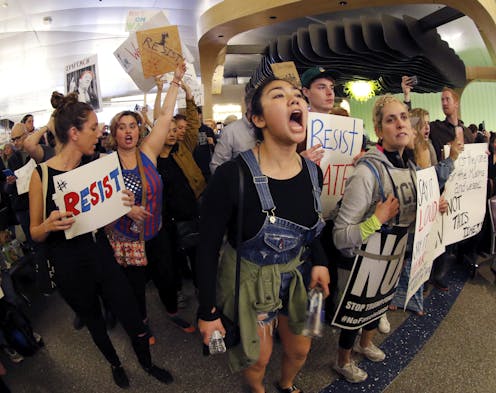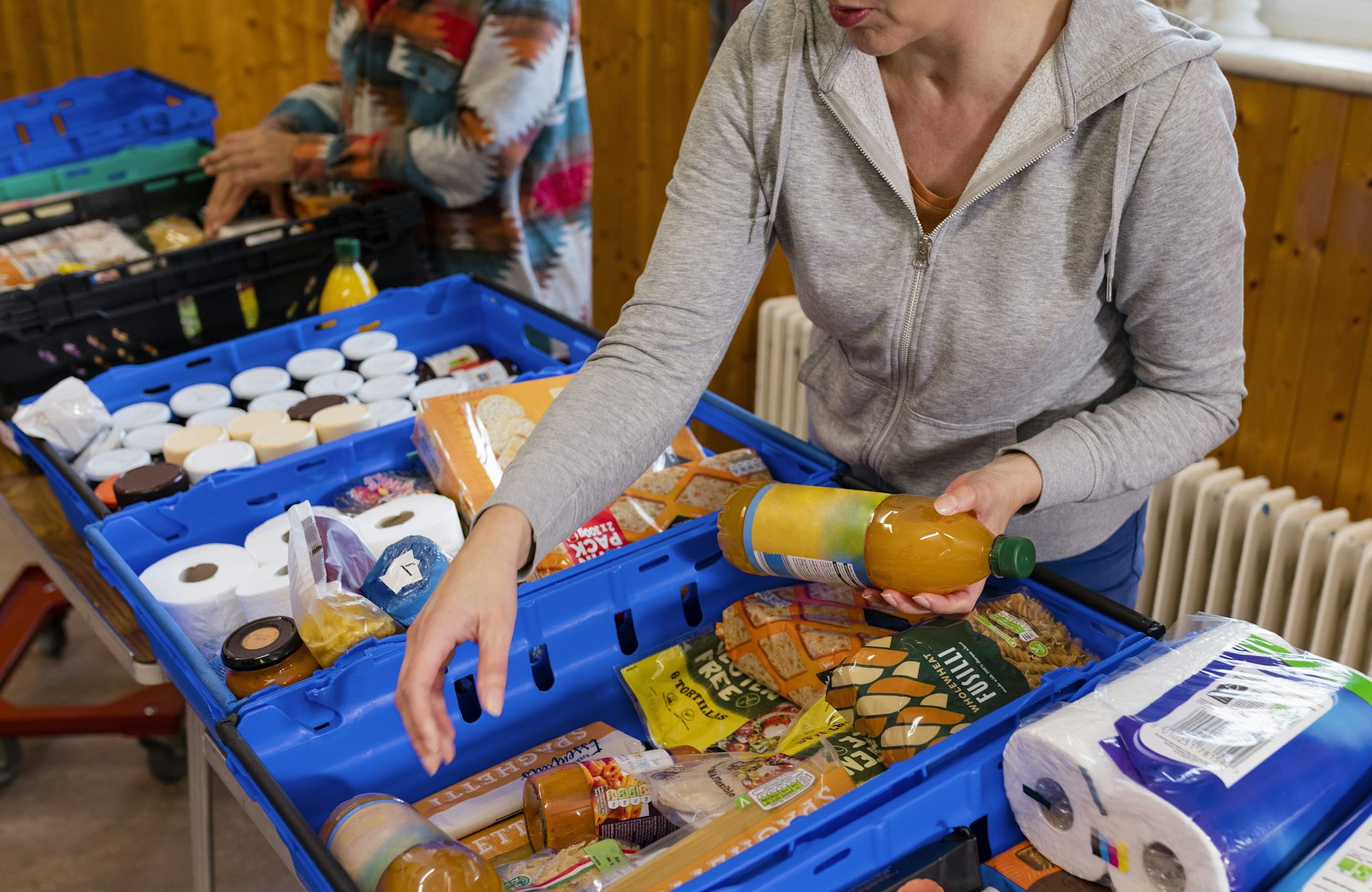Migration mayhem in 2017: 9 essential reads
A look back at how one of the most divisive issues of the Trump campaign played out during the first year of his presidency.

President Donald Trump did not waste any time pushing strict immigration policies in 2017, as promised during his campaign. What resulted was dozens of legal challenges, pushback from local leaders, nationwide protests and often widespread confusion. This is a roundup of some of the biggest stories on migration to and within the U.S. in 2017 from our archives.
1. Then there were three
On Jan. 27, Trump signed an order banning entry to the U.S. from seven Muslim-majority countries. The latest, and third, iteration of this ban spans six countries, and went into full effect on Dec. 4. The Supreme Court is expected to review the case in 2018.
Singling out people of certain faiths or nationalities is also an old problem in the U.S., write migration scholars David FitzGerald and David Cook-Martin. Discrimination of this sort echoes 19th- and 20th-century legislation that singled out, for example, immigrants from Eastern Europe and Asia. History suggests there will be a major backlash at the international that could put the U.S. at risk.
2. & 3. Learning how to resist
States and cities pushed back against the Trump administration. For example, San Francisco sued the Trump administration for threatening to withhold federal funding to so-called “sanctuary cities.” The case argued that the federal government was “comandeering” local law enforcement, in violation of the 10th Amendment to the Constitution, writes constitutional expert Anthony Johnstone of the University of Montana.
Local efforts to resist federal overreach can be traced back to the time of slavery. Under the Fugitive Slave Act of 1850, the authority of federal law enforcement officials expanded, writes historian Barbara Krauthamer of the University of Massachusetts, Amherst.
“Prompted to action … Boston’s black community gathered to plan their opposition to the Fugitive Slave Law,” she writes. “They adopted a set of resolutions, including a pledge ‘to resist oppression’ and any attacks on their freedom.”
4. Fighting immigrant detention
The government faced more legal challenges this year in response to more aggressive enforcement of a policy of holding immigrants in detention who are suspected to be in the U.S. without authorization. Public interest lawyer Kevin Johnson, a professor at the University of California, Davis, writes that detaining immigrants in the U.S. goes as far back as the late 1800s, when a wave of immigrants from China arrived in California.
Since then, Johnson writes, the government has faced myriad accusations of wrongdoing, including failing to provide the right to counsel to those in detention, detaining children and bias. If Trump’s aggressive crackdown on undocumented immigrants continues, the number of legal challenges to detention will likely increase.
5. Years in the making
The U.S. immigration system was a mess long before Donald Trump took office. Immigration courts have had too few judges to handle the high volume of cases. Lindsay Harris, a law professor at the University of the District of Columbia, writes that this immense backlog has caused average wait times to see a judge to rise to between two and six and a half years.
Many of these individuals enter the country seeking asylum, Harris explains, and are held in detention centers until they can be interviewed. The effects can be devastating.
6. A nightmare for Dreamers
Among those who fear the effects of the administration’s crackdown are “Dreamers” – people brought to the U.S. without authorization as minors by their parents. In September, the Trump administration rescinded an Obama-era policy that offered this group temporary protection from deportation and authorization to work, known as Deferred Action for Childhood Arrivals. It’s now up to Congress to come up with a solution for the more than 1 million young people who have grown up in the U.S. and call it home.
Wayne Cornelius, immigration expert at University of California, San Diego, writes that lawmakers should take this as an opportunity to improve upon an imperfect policy.
At the same time, he writes: “While there is a compelling case for some type of legislation to fill the gap created by DACA’s demise, Congress’s track record on this issue is dismal.”
7. More immigration ≠ more crime
Meanwhile, many immigrant advocates note that narratives that depict Dreamers as more deserving of a place in the U.S., compared to other undocumented immigrants, is problematic. They argue it reinforces the rhetoric about immigrants founded in fear and racism peddled by Trump and his supporters. One such fear is that undocumented immigrants bring crime into U.S. communities.
However, research on the link between immigration and crime is quite conclusive. Robert Adelman of University at Buffalo and Lesley Reid of the University of Alabama write:
“Immigration-crime research over the past 20 years has widely corroborated the conclusions of a number of early 20th-century presidential commissions that found no backing for the immigration-crime connection. Although there are always individual exceptions, the literature demonstrates that immigrants commit fewer crimes, on average, than native-born Americans.”
8. Puerto Ricans coming to the mainland
Public debate about who is deserving of compassion from the U.S. extended into the aftermath of Hurricanes Irma and Maria in Puerto Rico. The federal government’s response was criticized for being dangerously inadequate.
Demographer Alexis R. Santos-Lozada at Penn State points out that if recovery is not swift, states should prepare to permanently accommodate Puerto Ricans who migrated to the mainland. The longer recovery takes, the less likely it is they’ll return to the island.
9. Climate change and future migration
The disaster in Puerto Rico has drawn attention to the connection between climate change, natural disasters and migration. Economists Dean Yang and Parag Mahajan at the University of Michigan point out that U.S. lawmakers must think about how immigration policies can create or destroy life-changing options for people affected by disaster. More now than ever, as climate science suggests, we can expect the severity of natural disasters to increase.
Read These Next
Drones, physics and rats: Studies show how the people of Rapa Nui made and moved the giant statues –
The mysteries of Easter Island, subjects of speculation for centuries, yield to scientific inquiry.
George Plimpton’s 1966 nonfiction classic ‘Paper Lion’ revealed the bruising truths of Detroit Lions
George Plimpton, then a 36-year-old literary editor, endured the brutal realities of a professional…
What makes a true Santa is inside – and comes with the red suit
Researchers who surveyed 849 professional Santas found that one-third of them didn’t adhere to the…





